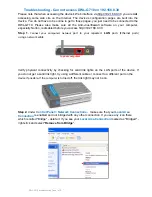
•
Press the
Mode
button on a stack member until the Stack mode LED is on. The last two port LEDs on
the Switch should be green. Depending on the Switch model, the last two ports are either 10/100/1000
ports or small form-factor pluggable (SFP) module. If one or both of the last two port LEDs are not
green, the stack is not operating at full bandwidth.
•
We recommend using only one CLI session when managing the switch stack. Be careful when using
multiple CLI sessions to the active switchstack master . Commands that you enter in one session are not
displayed in the other sessions. Therefore, it is possible that you might not be able to identify the session
from which you entered a command.
•
Manually assigning stack member numbers according to the placement of the Switch in the stack can
make it easier to remotely troubleshoot the switch stack. However, you need to remember that the Switch
have manually assigned numbers if you add, remove, or rearrange Switch later. Use the
switch
current-stack-member-number renumber new-stack-member-number
global configuration command
to manually assign a stack member number.
If you replace a stack member with an identical model, the new Switch functions with the exact same
configuration as the replaced Switch. This is also assuming the new Switch is using the same member number
as the replaced Switch.
Removing powered-on stack members causes the switch stack to divide (partition) into two or more switch
stacks, each with the same configuration. If you want the switch stacks to remain separate, change the IP
address or addresses of the newly created switch stacks. To recover from a partitioned switch stack, follow
these steps:
1
Power off the newly created switch stacks.
2
Reconnect them to the original switch stack through their StackWise Plus ports.
3
Power on the Switch.
For the commands that you can use to monitor the switch stack and its members, see the
Displaying Switch
Stack Information
section.
Preventing Autonegotiation Mismatches
The IEEE 802.3ab autonegotiation protocol manages the Switch settings for speed (10 Mb/s, 100 Mb/s, and
1000 Mb/s, excluding SFP module ports) and duplex (half or full). There are situations when this protocol
can incorrectly align these settings, reducing performance. A mismatch occurs under these circumstances:
•
A manually set speed or duplex parameter is different from the manually set speed or duplex parameter
on the connected port.
•
A port is set to autonegotiate, and the connected port is set to full duplex with no autonegotiation.
To maximize Switch performance and ensure a link, follow one of these guidelines when changing the settings
for duplex and speed:
•
Let both ports autonegotiate both speed and duplex.
•
Manually set the speed and duplex parameters for the ports on both ends of the connection.
Consolidated Platform Configuration Guide, Cisco IOS Release 15.2(4)E (Catalyst 2960-X Switches)
1642
How to Troubleshoot the Software Configuration
Summary of Contents for Catalyst 2960 Series
Page 96: ......
Page 196: ......
Page 250: ......
Page 292: ......
Page 488: ......
Page 589: ...P A R T VI Cisco Flexible NetFlow Configuring NetFlow Lite page 509 ...
Page 590: ......
Page 619: ...P A R T VII QoS Configuring QoS page 539 Configuring Auto QoS page 645 ...
Page 620: ......
Page 750: ......
Page 1604: ......
Page 1740: ......
Page 2105: ...P A R T XII Configuring Cisco IOS IP SLAs Configuring Cisco IP SLAs page 2025 ...
Page 2106: ......
Page 2118: ......
Page 2164: ......
















































